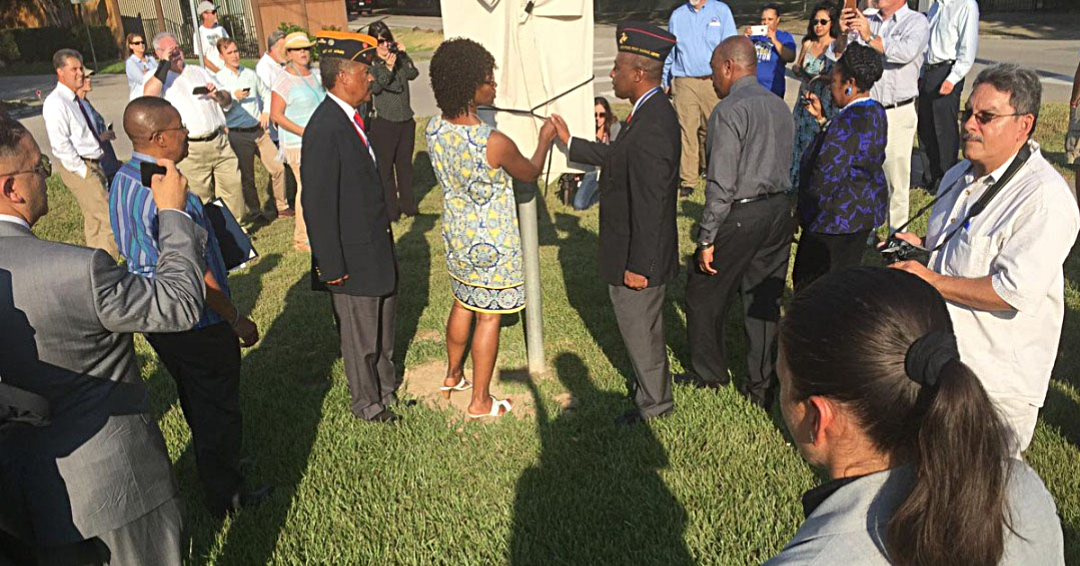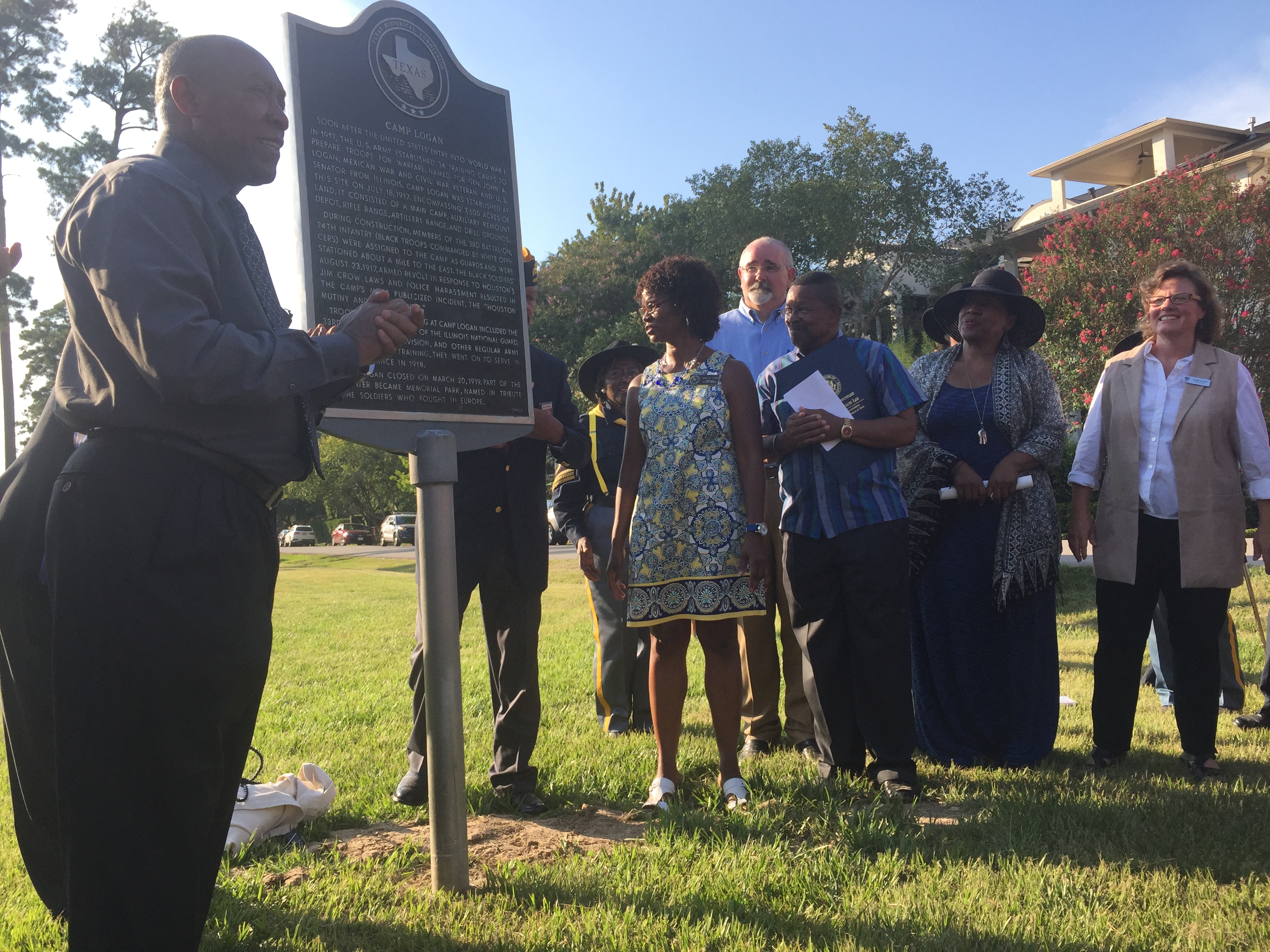Angela Holder first saw a photograph of her great uncle when she was six years old, growing up in Baton Rouge. Who is that, she asked her great aunt. It was the only time she remembers her great aunt looking sad.
Jesse Moore was one of 63 black soldiers tried in the first of three courts-martial following what is today known either as the Houston mutiny or riot of 1917. In total, 118 soldiers were charged in the wake of the August 23 riot that left 20 dead, more injured.
In his last letter to his mother, Moore maintained his innocence and sent his coat, a bible and one dollar. For years, his family knew pieces of the story. But it took Holder's own digging to uncover his fate. Moore was one of 13 soldiers hanged on December 11, informed of their impending executions only two days earlier. In total, 29 were given death sentences, though President Woodrow Wilson commuted 10 sentences amid public protests after the first round of executions was carried out in secret.
Since 2003, Holder and Captain Paul J. Matthews, the founder of the Buffalo Soldiers National Museum, have held annual observances of the date. For the 100th anniversary, they planned a week of events and ceremonies to remember the event that was largely unwelcome in the official Houston story for decades. In the mess of the rainy riot evening, few individual officers could have been accurately identified by witnesses, though some 200 testified in the trials. And historians have called into question that testimony, noting that the soldiers who testified as participants were granted immunity or promised leniency. Its legacy in Houston is, in some ways, still being decided as the country as a whole reckons anew with its violent, racist roots and how best to express that memory in public spaces. Camp Logan and the Houston riot are one chapter of many in that story but the 100th anniversary of the events of that August offer still another opportunity to reckon with the challenges of memory.
In addition to a rededication ceremony Wednesday for the small plaque tucked in the corner of what is today Memorial Park, Holder and Matthews also helped install and unveil headstones for three of the four black soldiers killed that night who had been buried without any kind of marker. And Holder said she is seeking a posthumous pardon for the other convicted soldiers, who were never given the opportunity to appeal the verdict and were sentenced with flawed testimony.
“We are trying to correct some of the wrongs here,” said Holder.
Mayor Turner reads the Camp Logan plaque.
No Unusual Occurrences
It can be hard to make sense of the carnage. The morning of the riot, a story in the local newspaper with the headline “Camp Logan Work Moving Smoothly” trumpeted the progress made on the camp’s construction, saying, “Camp Logan is one day nearer completion; a day marked by no unusual occurrences, but characterized by the same swift moving efficiency that is not unusual in the record of the big job.”
There were strategic reasons for the city to maintain a positive outlook on the project, which was bringing in an estimated $60,000 weekly to the local economy. In 1944 in the Journal of Negro History, Edgar Schuler chronicled the mismatch in tone between what was happening on the streets and what was showing up in the papers. It wasn’t until readers got to the 14th page of the Sunday paper on August 19, for example, that they would see a story about a black worker at the camp who was stabbed by a white man while waiting in line for their pay.
“Almost without exception the reports of developments published prior to the riot indicated that everything was serene in Houston and at Camp Logan,” wrote Schuler. The “good behavior” of the black soldiers, wrote Schuler, “was scheduled to be rewarded by giving them a watermelon feast at Emancipation Park that fateful Thursday night.”
Lingering Fears
When Houston was awarded Camp Logan, it was one of just 16 military training camps to be built across the country after the United States entered the first World War in April, 1917. The city and business community had lobbied for the camp and had their eye on an aviation school as well. The news was greeted with excitement, but also trepidation.
Just a year earlier, noted historian C. Calvin Smith, “a group of southern congressmen sponsored a bill to prevent the enlistment of blacks in the armed forces or the reenlistment of those already in uniform.” A black man in uniform was a not welcome sight for many white people and even with war looming, Southerners sought to keep them from serving. With the entry of the country into World War I, a new law lifted the quotas that had limited enrollment for black soldiers. Now, any black man who wanted to serve could. The Houston Chamber of Commerce assured the federal government that the black troops sent to guard the camp as it was built would be welcomed.
Before even arriving, the troops from the 24th infantry, who had served in Mexico, the Philippines and the Spanish-American War, had reason to doubt that. “Of all places where black soldiers served,” wrote Smith, “the documented record of ‘ill treatment’ and lack of respect was greatest in Texas.”
In 1898, after the all-black 10th cavalry completed its service in the Spanish-American War and was transferred to Texas, the soldiers were greeted with a hail of gunfire traveling on rail between Hunstville and San Anontio. The attack by white civilians was so severe, notes Smith, that the troops required a military escort. In 1906, 167 black soldiers stationed in Brownsville, Texas were dishonorably discharged and arrested, accused of conducting a violent raid on the city with conflicting evidence.
Houston, meanwhile, was a solid part of the Jim Crow South. Violent confrontations on segregated streetcars, frequent incidents of police brutality and political disenfranchisement marked daily life for the city’s black population. And the local white population was wary about more black people coming to the city. Anticipating the arrival of more black soldiers in August, A. S. Moody, vice chairman of Harris County’s Local Option Committee took out an advertisement in the newspaper asking:
Can the men of Harris County afford to vote to continue the saloon in face of this? For the security of the homes of this community and for the protection of the law-abiding negro, who will be helpless
MAKE HARRIS COUNTY DRY-REMEMBER BROWNSVILLE
There was news coming in constantly of race riots and near race riots elsewhere. When the 24th infantry arrived in Houston, they were disarmed, according to Smith, in an effort to make the troops “less of a threat to local whites and reduce the possibility of retaliation on the part of the soldiers for acts of injustice and humiliation.” Only guards on duty were allowed weapons.
Stark Contrasts
Angela Holder is a descendant of one of the soldiers executed in the wake of the riot.
The local press was not entirely wrong in calling the day before the riot a typical day but it failed to include that a typical day meant abuse and mistreatment of black citizens and soldiers alike. Indeed, what set off the particular chain of events that led to the riot, was the treatment a black laundress named Sara Travers.
On the pretense of looking for people involved in an illegal dice game, two Houston police officers, one with a reputation for bullying and abuse, entered her home. “She challenged them,” said Holder, a professor at Houston Community College and a board member of the Buffalo Soldiers National Museum. The police officers beat her and dragged her, dressed only in intimate apparel, into the street. When a black soldier, Alonzo Edwards, tried to intervene, he was pistol whipped and arrested.
When word got back to the camp, Corporal Charles W. Baltimore, one of the most popular at the camp, went to the police officers to ask after the soldier who had been arrested. Again, the police officers attacked. As Baltimore fled, they fired at him, eventually catching him and beating him as well. In his absence, rumors spread around the camp, including that he had been killed and that a white mob was forming to attack the camp, according to Smith. Though Baltimore returned later after the white commanding officer secured his release from jail, the camp was still on edge.
Accounts differ as to what happened next. According to the official account and the one given in Robert Haynes’ A Night of Violence: The Houston Riot of 1917, rumors of a white mob were manufactured by those planning to riot against the police in retribution. But Smith maintains that the rumors were organic and sincere, set off by weeks of escalating tensions.
“The soldiers were reacting to what had been going,” said Holder, who is working on a book about the soldiers.
According to Smith’s account, “the evidence is clear that Camp Logan had been fired into by outside forces and that the frightened soldiers panicked, seized their weapons, and left camp to meet their assailants.”
The march led them down Washington Avenue, as they made their way downtown before clashing with police and civilians. The roughly two-hour riot was characterized as indiscriminate in its killing but testimony given at the trials indicates that the soldiers told several civilians to stay off the streets.
In the wake of the violence, the city was placed under martial law. More than 100 soldiers were arrested. Black neighborhoods were searched and raided by police and others, stripped of any weapons they might have. The trials occurred in three batches with one lawyer handling the cases of 63 men. Of the 118 charged, 110 were convicted of some crime.
Reaction across the country was divided. The white press, wrote Smith, talked about it as “one of the most disgraceful mutinies of American troops in our history,” while the black press spoke against what it saw as an injustice.
“When you have a president who says we have to make the world safe with democracy,” said Holder, “with what is erupting at home, it’s a stark contrast.”
Shouting Out
At the rededication ceremony for the commemorative plaque in Memorial Park remembering the events that took place 100 years ago, Mayor Sylvester Turner tells a small crowd gathering around two white tents set out in the grass that it is an occasion for reflection. Recounting the history, he said, “I believe all of that is calling us today to be better,” and spoke out against prejudice today. “The history of Camp Logan is shouting out in 2017,” he said, for good people of all backgrounds to speak against hate and stand united.
As the city deliberates on what to do with its statues honoring the Confederacy and white supremacists gather in cities across the country hoping for attention and inciting violence that has already claimed one woman’s life in Charlottesville, reckoning with the full weight of history is an ongoing challenge.
“The ultimate results were not ones that we would celebrate,” said Congresswoman Sheila Jackson Lee, but she emphasized the importance of telling the truth, the whole story. “We did not get it right,” she said, of Camp Logan. “We will fail in another 100 years if we don’t find ways to discuss race and racism.”
Holder hopes, as she does every year, that remembering Camp Logan and the riot will renew calls for tolerance and the equality of all citizens under the law. And she hopes that her great uncle, as well as all the others would did not receive the due process they deserved, can be offered another life in death.
“We may not be celebrating the cause that brought them there but they should at least be remembered for their service,” said Holder.



